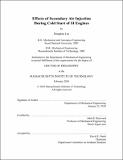Effects of secondary air injection during cold start of SI engines
Author(s)
Lee, Dongkun
DownloadFull printable version (2.810Mb)
Other Contributors
Massachusetts Institute of Technology. Dept. of Mechanical Engineering.
Advisor
John B. Heywood.
Terms of use
Metadata
Show full item recordAbstract
The paucity of exhaust oxygen during cold start of automobile SI engines limits the extent of exothermic chemical reactions in the exhaust port, manifold, and catalyst. The injection of air into the exhaust system therefore could be an effective way to utilize additional thermal and chemical energy available in the exhaust gas. This study was initiated to investigate the thermal and chemical processes associated with secondary air injection (SAI) inside the exhaust system in order to maximize the simultaneous benefit of reducing converter-in emissions and improving catalyst lightoff performance during cold start. An experimental study was performed to develop a more fundamental understanding of the effects of SAI on exhaust gas emissions and catalyst light-off characteristics during cold start of a modem SI engine. The effects of several design and operating parameters such as spark retardation, fuel enrichment, secondary air flow rate and air injection location were investigated to understand the mixing, heat loss, and thermal and catalytic oxidation processes associated with SAL. Time-resolved HC, CO and CO2 concentrations were tracked from the cylinder exit to the catalytic converter outlet and converted to mass flow rates by applying an instantaneous exhaust mass flow rate model. A phenomenological model of exhaust heat transfer combined with the gas composition analysis was also developed to define the thermal and chemical energy state of the exhaust gas with SAT. The study found that significant emissions reduction can be achieved with SAI by the thermal oxidation process prior to the catalyst, which results in enhancing the chemical process inside the catalyst by faster catalyst light-off. The engine operation, with a relative air/fuel ratio 20% rich of stoichiometric and 100% secondary air, yielded the fastest catalyst light-off (4.2 sec). The SAI system reduced HC emissions by 46% to 88% and CO emissions by 37% to 93% compared with the normal operating conditions. The analysis showed that the post-catalyst HC emissions levels were optimized with secondary air flow rates corresponding to an overall exhaust lambda of 1.3.
Description
Thesis (Ph. D.)--Massachusetts Institute of Technology, Dept. of Mechanical Engineering, 2010. Cataloged from PDF version of thesis. Includes bibliographical references (p. 115-117).
Date issued
2010Department
Massachusetts Institute of Technology. Department of Mechanical EngineeringPublisher
Massachusetts Institute of Technology
Keywords
Mechanical Engineering.